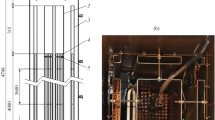Abstract—
The article presents and analyses the results from first-priority thermophysical investigations aimed at assessing the characteristics and safety of water-cooled reactors, including enhancement of the nuclear fuel technical and economic characteristics, design solutions for passive safety features, and stable operation of the passive heat removal system (PHRS) air-cooled heat exchangers under extreme meteorological conditions. It is shown that the fuel assembly (FA) critical power level depends both on the type and number of spacer and mixing grids and on the burnout occurrence spot. The critical heat fluxes that occur when the coolant flowrate drops by 4% are higher in unsteady modes than they are in steady modes of operation at the same flow parameters. Information about the upgraded base of estimated experimental data on the critical heat fluxes in the new FA designs is given. The article also presents data on pressure variations in the main components of the RU-ZO experimental bench (containing the reactor plant and containment models) in the experiment modeling an accident involving reactor coolant pipeline (RCPL) rupture at the reactor inlet (scenario 1) and decrease of the steam generator (SG) model condensing power in the bench (scenario 2). It is found that the drop of SG condensing power is approximately 30% of its level at the onset of the SG condensing operation mode during accidents according to both the scenarios. However, the remaining condensing power level is sufficient for reliably cooling the VVER-1200 reactor core for no less than 24 h with joint operation of the second-stage hydro accumulators (HA-2) and PHRS. Experimental investigations of the external aerodynamic characteristics of the Novovoronezh-2 NPP (NVNPP-2) main building aimed at checking if proper operation of the PHRS is secured independently of the wind load have shown that extreme meteorological conditions, including hurricane winds and dust storms, may manifest themselves in a decreased capacity of part of the PHRS air-cooled heat exchangers. Studies carried out for assessing the design of a water-cooled nuclear power facility (NPF) for an electrical power capacity of 1700 MW operating at supercritical parameters and the experimental VVER-SKD-30 reactor with a thermal power capacity of 30 MW are mentioned. The problems that have to be solved in carrying out further thermophysical investigations of water-cooled reactors for supercritical parameters are listed.










Similar content being viewed by others
Notes
VVER-TOI is the transliterated Russian name of the conceptual optimized NPP design based on the technology of pressurized light water reactors with enhanced support by information technologies.
REFERENCES
N. N. Ponomarev-Stepnoi, “Two-component nuclear power system with a closed nuclear fuel cycle based on BN and VVER reactors,” At. Energy 120, 233–239 (2016).
R. Z. Aminov, A. F. Shkret, and M. V. Garievskii, “Thermal and nuclear power plants: Competitiveness in the new economic conditions,” Therm. Eng. 64, 319–328 (2017). https://doi.org/10.1134/S0040601517050019
A. V. Morozov, A. S. Shlepkin, D. S. Kalyakin, and A. S. Soshkina, “Studying the operation of a VVER steam generator in the condensing mode at different parameters of emergency processes,” Therm. Eng. 64, 329–335 (2017). https://doi.org/10.1134/S0040601517050044
A. V. Morozov, A. P. Sorokin, S. V. Ragulin, A. V. Pityk, A. R. Sakhipgareev, A. S. Soshkina, and A. S. Shlepkin, “Effect of boric acid mass transfer on the accumulation thereof in a fuel core under emergency modes at NPPs with WMR,” Therm. Eng. 64, 490–495 (2017). https://doi.org/10.1134/S0040601517070047
P. L. Kirillov, “Changing over to supercritical parameters: The way to advance nuclear power stations with water-cooled reactors,” Therm. Eng. 48, 973–978 (2001).
P. L. Kirillov, “Water-cooled reactor WWER SCP (preliminary developments),” Izv. Vyssh. Uchebn. Zaved., Ser.: Yad. Energ., No. 1, 5–14 (1993).
V. A. Mokhov, V. Ya. Berkovich, M. P. Nikitenko, V. M. Makhin, A. N. Churkin, A. V. Lapin, P. L. Kirillov, Yu. D. Baranaev, and A. P. Glebov, “Conceptual proposals on VVER-SCP reactor prototype,” Vopr. At. Nauki Tekh., Ser.: Obespechenie Bezop. AES, No. 34, 84–92 (2014).
V. A. Grabezhnaya and P. L. Kirillov, “Heat transfer in pipes and rod bundles during flow of supercritical-pressure water,” At. Energy. 96, 358–364 (2004).
Author information
Authors and Affiliations
Corresponding author
Additional information
Translated by V. Filatov
Rights and permissions
About this article
Cite this article
Sorokin, A.P., Kuzina, Y.A., Trufanov, A.A. et al. Topical Problems Concerned with the Thermophysical Characteristics of New-Generation Light Water Reactors: Comprehensive Study Results. Therm. Eng. 66, 235–242 (2019). https://doi.org/10.1134/S0040601519040098
Received:
Revised:
Accepted:
Published:
Issue Date:
DOI: https://doi.org/10.1134/S0040601519040098



